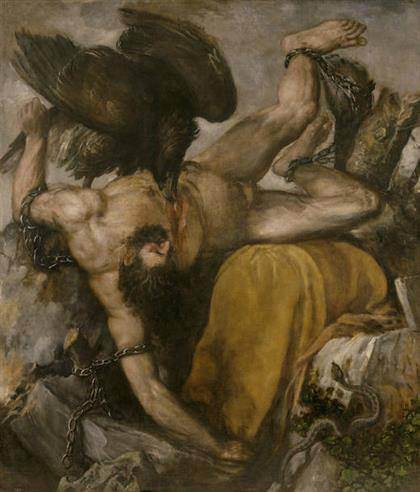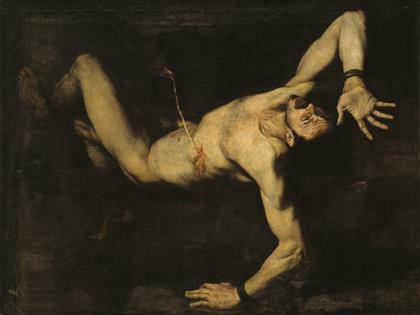
Titian: “Tityus“, 1560 – 1565
Oil on canvas, 253 x 217 cm
Madrid, Museo Nacional del Prado

José de Ribera : “Tityus“, 1632
Oil on canvas, 227 x 301 cm
Madrid, Museo Nacional del Prado
Prado Museum presents the exhibition ‘The Furias’ The Museo del Prado in Madrid analyses the rise, evolution and decline of the subject of the ‘Furias’, from the time of its appearance in European art in the mid-16th century to the late 17th century. January 21 – May 4, 2014.]]>
Source: Museo del Prado, Madrid
The exhibition includes 28 works, including a drawing by Michelangelo loaned from the Royal Collection in London and paintings by Rubens, Rombouts, Goltzius, Assereto, Rosa and Langetti. Also on display are the Prado’s versions of the “Furias” by Titian and Ribera and its Tityus enchained by Gregorio Martínez, acquired in 2011. Together, these works illustrate the success enjoyed for 120 years by the subject of the “Furias” at a time when rulers used them as political allegories and painters saw them as an ideal vehicle for illustrating supreme mastery in art, both in a formal sense, given that they are huge, nude figures in improbable foreshortenings, and in expressive terms, as the most overt representation of suffering.
“The Furias. From Titian to Ribera” offers an in-depth analysis of the Renaissance and Baroque’s interpretation of antiquity and looks at the circulation and exchange of artists, works and aesthetic ideas across Europe in the 16th and 17th centuries. In addition, it encourages a reflection on why certain forms acquire meanings that are passed down from one generation to the next.
Divided into five sections, the exhibition includes 2 drawings, 8 prints, 1 medal and 16 paintings and centres on a copy of the Laocoön from the Museo de Escultura in Valladolid. The first section looks at the only iconographic precedent for the group commissioned from Titian, which is a drawing of Tityus by Michelangelo of 1532, exhibited for the first time in Spain. A view of the Great Hall in the palace at Binche, created to welcome Charles V and Prince Philip, opens the second section, which is devoted to the group commissioned from Titian by Mary of Hungary. The third section looks at Haarlem and Antwerp in the final years of the 16th century and the early 17th century when these cities were the first centres for the reception of the subject of the Furias, based on the Laocoön. The fourth section illustrates the subject’s “return” to Italy, the role played by Flemish and Dutch artists in this process and the importance of Naples as the Baroque capital of the Furies with Ribera as their maximum exponent. The exhibition ends with the dissemination of the subject across Italy, terminating in Venice with Langetti and the tenebrosi and thus closing a circle initiated by Titian.
Related content
Late Raphael at the Prado Museum (exhibition, 2012)
Follow us on:


